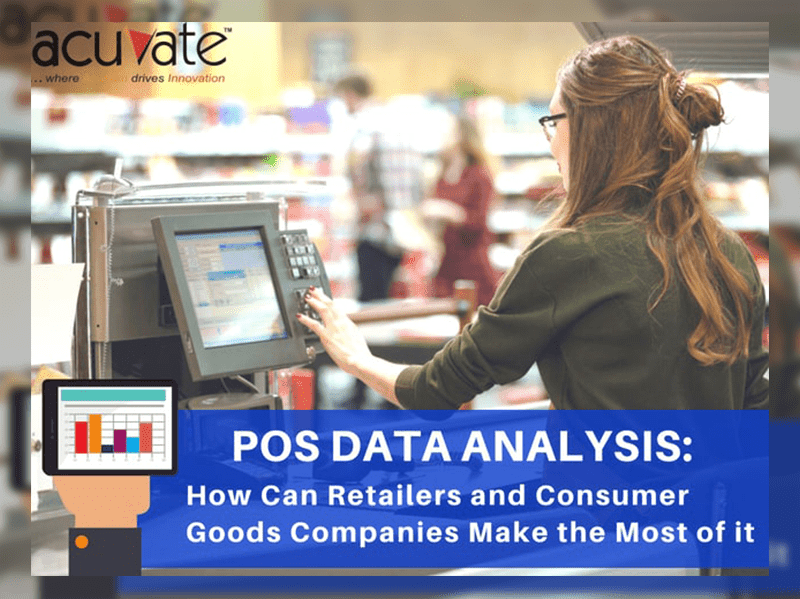Just to give a glimpse of the potential and magnitude of POS data, let me share something here. Walmart alone processes one million transactions every hour, feeding databases that exceed 2,500 terabytes – more than a hundred times the size of the Library of Congress.
This tells us why most consumer goods manufacturers and retailers who need a competitive edge spend heavily on purchasing POS data from data brokers like Nielsen and IRI.
While they capture huge data sets, little do the retailers and manufacturers know how to harness it and channelize it for the best use.
Read more: Data Brokers: How Can Consumer Goods Companies Maximize ROI
Such large data sets are discovered gold mines but are not malleable into anything concrete until retailers bring in powerful analytics which can process the data into meaningful insights. I intend to answer two questions in this article that will help you in reaping monetary benefits out of this effort.
You will understand – how retailers and manufacturers can use this data and how POS data can be analyzed.
Read more: Advanced Analytics: 4 Simple Steps For Enterprise Adoption
POS Data Analysis – How to Use POS Data and Make the Most out of It?
Retailers and manufacturers can draw insights about consumer behavior using data from POS machines, which provides a multi-dimensional correlation between timings, purchases, inventory, seasons and many other parameters. Here are some ways POS data can help. POS data provides the basket-level analysis at each outlet which is very essential for understanding consumer behavior and trends – something which can’t be obtained with primary and secondary sales data.
POS Data Analysis – Products On-Demand, No Inventory Lags.
A consumer’s top complaints about non-purchase have been poor pricing and lack of variety and quality of goods in a retail store. Data derived from POS terminals tell how consumers are responding to pricing for different goods and how a retailer can manage existing inventory levels.
Are Your Trade Promotions Generating The Desired ROI?
check out Compass: An AI-Powered Trade Promotion Optimization Solution
The other biggest trouble with inventory is to know what is available at the store and what is not. The codes assigned to different products allow in monitoring trends in stock availability and consumption across clustered and individual time periods. The trending product revealed by a POS tracking report helps store managers to order more of a product that generates more sales and profits.
Time-Sensitive Positioning
The big error, most retailers falter upon is to pick an average number of products sold as a parameter to increase or decrease the purchase and storage of products. The reality is that this number is flawed to fit in during special occasions like weekends, festive seasons and so on.
When you check this information by every hour and respond with appropriate inventory counts, that is when the retailer would start reaping more profits with right volumes.
Optimize OOS Schedule With POS Analysis
Out-Of-Stock (OOS) is a desisted phrase among retailers since it slows down sales while real demand strikes. POS data reveals a trend that tells which of the products are in demand at what time during a day or week or year. This helps retailers tighten priorities in stocking the right products in their stores. The biggest advantage you can enjoy as a retailer is to also manage different product categories with enough stock, seamlessly. Hourly sales data with significant gaps during peak sales periods would determine how to tackle with OOS issues to every detail.
Identify Sale Trends With POS Analysis
POS data tells you accurately the sales and profits earned from each store. However, to optimize the productivity of store with the learnings from other stores can help boost the profitability of each store. The comparable data of how revenues are occuring is easily accessible from POS data. It enables productivity at a granular level which helps to get to the details of each product, category, shelf, and store.
Trade Promotion Optimization
With POS data, retailers can enhance and optimize their trade promotion empowered by more accurate decision-making as they exactly know what is happening at the point of sales, how exactly consumers are responding to specific trade promotions, the effect of weather, special events like football or basketball matches etc.
This enables retailers to accurately measure the effectiveness of trade promotions run, what is the promotion ROI, what is the sales uplift for each promotion etc. This will enable them to plan their future promotions better and run promotion which yield high ROI. They can also effectively optimize their price-promotion strategies based on this data.
Read more: Trade Promotion Optimization: Challenges and How AI Can Help
Supply Chain And Warehouse Management
You bring goods out of the warehouse, send it to distributors and retailers and assume that it will simply get into a customer’s cart. Returns, exchanges and refunds add delineation to this flow of sales cycle. POS data also predicts a trend around such interruptions, creating a more cohesive flow of product distribution among different stakeholders.
Measure & Optimize Your Trade Promotions Effectively
Compass: An AI-Powered Trade Promotions Optimization Solution
Use POS data for Market Basket Analysis
The POS data further helps you gain deeper insights into your consumers by analyzing which specific products they are buying and what are the products which are bought together. This helps retailers plan Promotions better by deciding which can be the combination of products which can be bundled in a promotion and for what kind of customers based on age, ethnicity etc., by combining information from the loyalty card program. These insights also help retailers to plan their store layouts better by arranging the merchandise of the most likely products bought together.
How POS Data Can Be Analyzed by Retailers?
POS data is a gold mine for retailers to clearly understand consumer behaviours and the impact of sales at each store. Even though most retailers capture and store POS data, they don’t know what to do with it. Harnessing large data sets like POS data need powerful analysis which can be done using AI-Powered advanced analytics softwares.
Traditional analytics unfortunately provide shallow insights. With advanced analytics like predictive and prescriptive analytics, raw data can be transformed into actionable insights. Compass integrates POS data with several other internal and external data sources like Weather, primary sales, secondary sales, events, social media etc., and uses advanced analytics to harness them.
With Compass, you can know promotion effectiveness, optimize trade promotions, forecast sales, run profitable marketing campaigns etc. It is enabled with chatbots for better data delivery.
If you’d like to learn more about this topic, please feel free to get in touch with one of our experts for a personalized consultation.




